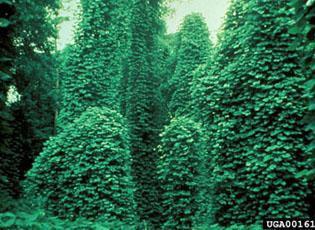Pueraria montana var. lobata
Kudzu
Synonym(s): Dolichos labatas, Pueraria hirsuta, Pueraria lobata var. thomsonii, Pueraria thumbergiana
Family: Fabaceae
Duration and Habit: Semi-woody perennial vine

Photographer: James H. Miller, USDA Forest Service
Source: Invasive.org
Description
Kudzu (Pueraria montana) is a wild variation of Pueraria from the family Fabaceae which includes legumes and peas. The leaves are a three part leaflet, each measuring an average of 4 inches across with hair, and deep lobes. Half inch purple flowers appear in late summer, releasing a strong fragrance. During the fall months the flower becomes a seed pod.
Ecological Threat: Kudzu is capable of growing at an alarming rate of up to 1 foot a day when conditions are optimal. This rapid growth allows for the plant to take over areas and prevent growth of native plants by consuming resources and smothering with their thick leaf growth. This plant can be useful in preventing soil erosion in areas, but once planted it will spread and prevent growth of native plants and crops.
Biology & Spread: Seed germination is low in the kudzu plant (three seeds per pod), which may require a germination period of three years after release. Primarily reproduction occurs via rhizomes that expand with root runners or nodes on the vine.
History: Kudzu was introduced in the United States in the 1800's as an ornamental plant and livestock control.
Habitat: Kudzu is commonly found in disturbed areas such as roadsides, and prefers sandy areas with mild winters and hot summers. It can also be found in forests or meadows growing across the ground or attached to trees (pictured above).
Distribution
Native Origin: Asia
U.S. Present: AL, AR, DE, FL, GA, HI, IA, IL, IN, KS, KT, LA, MA, MO, MD, MS, NC, NE, NJ, NY, OH, OK, OR, PA, RI, SC, TN, TX, VA, WA, WV
For a CAPS/CERIS/USDA map of past/present distribution, survey and eradication efforts click here.
Management
According to the U.S.D.A there is no way to completely eradicate kudzu because it grows at a rapid rate and in places that are not easily accessed. Chemical treatments can be effective in containing the plant, but complete eradication is not realistic once it has become established. Early detection and prevention are the best known management methods for the aggressive plant.
Text References
Forseth, Irwin N., and Anne F. Innis. 2004. Kudzu (Pueraria montana): History, Physiology, and Ecology Combine to Make a Major Ecosystem Threat. Critical Reviews in Plant Science 23(5).
Randall, J.M. and J. Marinelli. 1996. Invasive Plants:Weeds of the Global Garden. Brooklyn Botanic Garden Club, Inc. Handbook No. 149. 111 pp.
Virginia Native Plant Society. 1995. Invasive alien plant species of Virginia: kudzu [Pueraria lobata (Willd.) Ohwi]. Virginia Department of Conservation and Recreation, Richmond, Virginia.
Internet Sources
http://www.invasivespeciesinfo.gov
http://www.nps.gov/plants/alien/fact/pumo1.htm
http://pest.ceris.purdue.edu/map.php?code=PCQBPBA#
 Texas Invasive Species Institute
Texas Invasive Species Institute